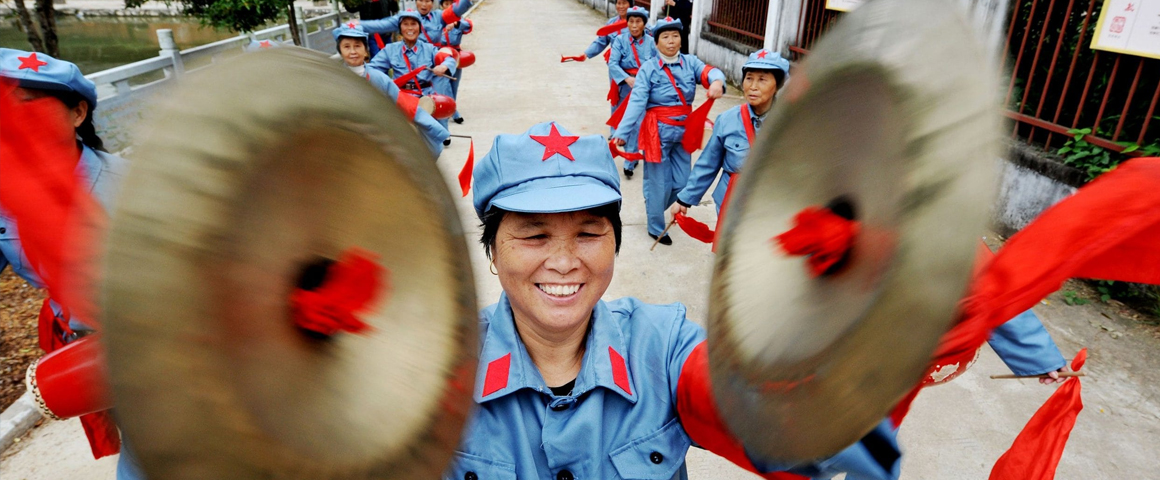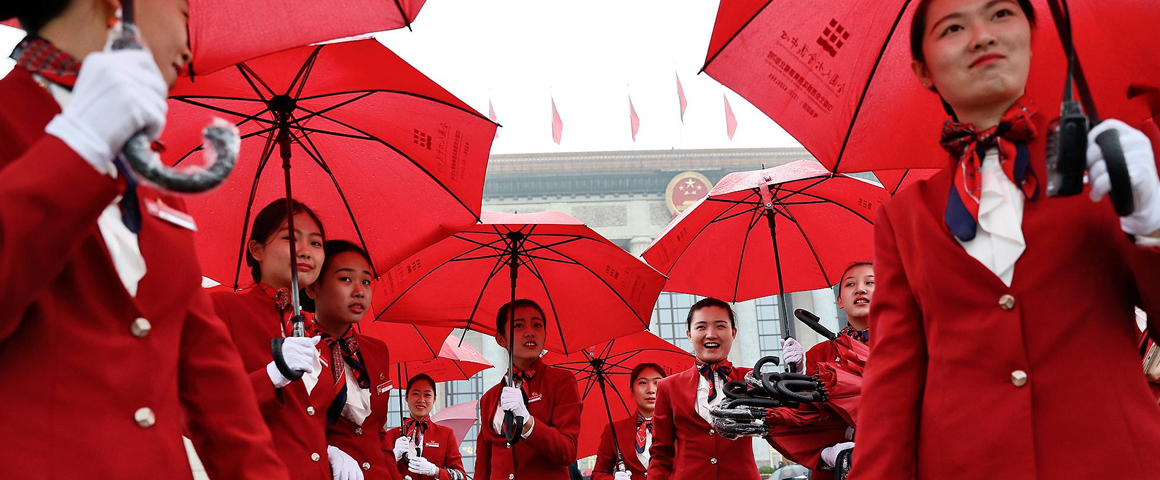Any evaluation of gender (in)equality in the People’s Republic by a Western man with a less-than-rudimentary knowledge of Chinese must be tentative.
But let’s begin by noting that one State does not equal one condition. Like all large countries (and not only large ones), China is a land of regions with significantly different levels of development and varying cultural tendencies. It is no great insight to point out, for example, that the ‘politics’ of the domestic sphere – the household – are significant in determining the public status of women. Equality before the law and even State promotion of female workforce integration and social participation may, obviously, have limited effect if women are left with most or all of the responsibility for domestic chores and childrearing. And it is true that, in general, Chinese women see their career opportunities and chances for participation in politics and social organizations limited by the tendency to leave them with more responsibilities at home.
But to what extent do children and chores limit them?
A fairly recent poll revealed 61.6 per cent of Chinese men and 54.6 per cent of women agreeing with the statement that “the field for men is in public and the domain for women is within [the] household.” Worrisome for equality advocates was the fact that these percentages had climbed markedly since a similar poll was conducted in 2000. (What was unclear was whether respondents felt that these roles were merely descriptive of current conditions or how things naturally ought to be).
Yet Chinese women and men I have questioned on the topic are critical of such data, suggesting they distort a more complex reality. In fact, these citizens say, there are great regional and class variations on the theme.
I live in a megacity where, at first glance, China’s claims to still be a “developing country” appear excessively modest. In huge, industrial (or what many would call post-industrial) Shanghai, an urban area with possibly the highest level of female workforce participation on the planet, relations aren’t what the poll cited above imply. Most men do gallons of housework here, it is said. A very intelligent and well-informed colleague of mine who is also a Party member insists that men in Shanghai are on the whole strongly egalitarian. They grew up in households where women were powerful and employed in factories, schools and shops. These men carry enlightened attitudes into their own romantic relationships and marriages.
Fathers here are certainly visible in and around the ubiquitous training centres to which children of all ages are towed after school and on the weekend in quest of an academic edge. Many spend hours on homework with their child.
“It’s a north-south difference,” says my friend, arguing that Northern men (whom she asserts frequently retain and revel in patriarchal attitudes) make fun of “obedient” Shanghai husbands who are “scared” of their wives. In the same vein, Shanghainese from working class and professional backgrounds argue that patriarchy is a holdover from the rural, peasant household. Continued modernization will eradicate it. No surprise in that argument.
Another regional difference: Illiteracy rates for women are higher than those of men across China, but a level of 5 per cent in Shanghai, Guangdong and Xinjiang becomes 49 per cent in Tibet, according to official PRC data.
Certainly, there is no question that the material status of women has been greatly enhanced by economic development and the resultant reduction of poverty. Critics on the left made a great deal of hay from China’s post-Mao, export-oriented strategy that saw the movement of millions of young adults from farms to factories where conditions were less than First World and labour rules generally flouted by Dickensian employers. But this revolution did precisely what Marxists and feminists knew (or ought to have known) it would: free a generation of young women from what was often the petty tyranny of a peasant father or husband and an accompanying life of drudgery. Of course, the factories they entered were a limited form of liberation, but real nonetheless, offering salaries, personal mobility, and increased freedom to form relationships of their choice… among other opportunities.
In many cases this difficult and often terrifying process also forged women fighters ready to hit back when their bosses refused to honour agreements, pay wages or make contributions to social funds. [see Labour in China: harmony or struggle? PV, March 16-31, 2018].

Income growth across the board
Wages have climbed steadily in all sectors over the last decade, always in dramatic fashion, and certainly in sectors where huge numbers of women work. In the period from 2005-2016, for example, and according to China’s National Bureau of Statistics, average manufacturing earnings climbed by over 200 percent after accounting for inflation. Real wages for wholesale and retail employees increased even more dramatically. Salaries grew less sharply in hotels and catering, but the climb still appears to have exceeded 150 per cent, even allowing for inflation totals beyond the official rate. In education, another sector in which women are numerous and often prominent, wage growth was in the vicinity of 250 per cent.
To be sure, these figures are averages that hide inequities. They include earnings by managerial personnel. But whatever qualifications may be applied to such data, they indisputably indicate a stunning rise in personal prosperity in which women are active participants. Indeed, this is consistent with the comments I receive from numerous persons critical of assorted policies and practices in People’s China. After a litany of often well-founded gripes, they say, “but after all, what you can’t deny is that all of us are much richer than our parents and grandparents were.” And naturally “all of us” includes women.
The fruits of the Communist Party’s long-standing commitment to gender equality – and the ambition of contemporary Chinese women – are apparent in other data as well. Despite being outnumbered in society as a whole, women are now more numerous than men in universities. And between 2000 and 2013, female middle-ranking and senior technical staff climbed from 35 to 44 per cent of the total, according to Vivian Yang of the Beijing office of the World Economic Forum.
Meanwhile, 55 per cent of internet firms are the creations of women, and over one quarter of the country’s entrepreneurs are female, possibly a world-beating figure.
Certainly, one can’t discuss the status of women in the country without reflecting on the famous (or infamous) one-child policy, in effect from the end of the 1970s until 2016. (National minorities in the PRC were exempt from the rule, as were, to a lesser extent, Han Chinese in rural areas). Critics, Western and otherwise, have not unreasonably focused on the draconian penalties imposed on women and their husbands who had additional children during this epoch. Many lost their jobs and were condemned to eke out a marginal existence on the fringes of society. Heavy fines were levied. Some observers have even questioned the policy’s effectiveness in limiting population growth.
But what undoubtedly is true is that the one-child rule enabled women’s public role. Careers, though interrupted by one baby, were not derailed. A battery of supports such as public childcare and grandparents who retire earlier than their Western counterparts (men frequently at 60 and women at 55 or 50) and were hence available to mind a child during after-school hours, made further contributions.
Surely this allowed China to boast the highest rate of female labour market participation in the world.
And if one male child meant a veritable prince in the house, a single girl meant a princess. One who is often no doubt spoiled, but who also receives almost every quality advantage and conceivable benefit that two parents and two sets of grandparents can shower upon her. The girl’s education becomes a sacred cause and her future a topic of intense concern.
This does not mean that seeing her “well-married” ceases to be her family’s objective. But no limits are set on her potential educational and professional achievements. Chinese parents who desire marriage for their daughters (and often know how to apply intense pressure in this direction, as does the larger society) frequently ridicule the real “princess” syndrome – the notion that simply being beautiful and thereby landing a well-to-do husband is a realistic life plan.

Pressure to be perfect
Which isn’t to say that the heat applied in the appearance department isn’t intense. China, due to traditional reasons as well as ones stimulated by a vibrant market culture, values feminine beauty. Or rather, demands it. Women of all urban strata are under intense pressure to be slim, to be immaculately groomed, to dress fashionably and to glow. They are required to be good workers, good students, good mothers and beautiful. They are, in short, “invited” to be perfect. Men, meanwhile, if they are doing well enough in their professional lives, are cut ample slack in the other spheres of existence.
This, for woman, is the tortuous side of their emancipation in the PRC. They can be everything they want to be… and objects of sexual desire and pieces of human décor too. A daunting task, undoubtedly.
The information conveyed by the standard signposts of equality remains telling. Some 24 per cent of delegates at the Party congress last October were women, one point higher than party membership overall. The Communist Party Politburo includes only one woman out of 25 members.
“One low and three small” is the expression that continues to characterize the situation: a low overall proportion of women in politics; a small number of women in top positions; a relatively small number of women taking positions at higher levels generally; and a relatively small number of women holding important positions in key sectors.
Yet perhaps the next step ought not to be a special emphasis on getting more balance at the top but rather energizing the bottom. Where can Chinese women be found in massive numbers? In the factories, offices, schools and hospitals of the country. According to Chinese law, “labourers shall take part in democratic [enterprise] management through workers’ congress[es], workers’ representative assemblies, or any other forms in accordance with law…”
The route to emancipation certainly runs through this territory. Mobilizing workers in defence of their rights and the management of their enterprises necessarily involves the mobilization of women. Right now, overall, male and female workers in China are far too tentative in this regard. But this, the smaller, immediate yet strategic space, can be the real arena of popular participation. And when things are churned at the bottom, effects will be felt at the male-dominated top.
Some facts and figures
China’s Constitution states in Article 48, “Women in the People’s Republic of China enjoy equal rights with men in all spheres of life, in political, economic, cultural, social and family life”. It adds, “The State protects the rights and interests of women”. Likewise, the Law of People’s Republic of China on the Protection of Rights and Interests of Women underscores the equal rights of men and women, and says in Article 2, “Discriminating against, maltreating, abandoning and physically abusing women are prohibited”.
On a global scale, gender inequality in China is relatively low. In 2014, China ranked 40th out of 187 countries in the United Nations Gender Inequality Index. China’s maternal mortality ratio in 2015 was 27 out of 100,000 live births, compared to 19 in the US (2016). As of 2014, 59% of women (aged 25 and older) have completed secondary education or more, compared to 72% for men, and women’s labour force participation rate was 63.9% (78.3% for men). Women hold 24.9% of seats in the National People’s Congress (compared to 27% in Canada’s Parliament)




